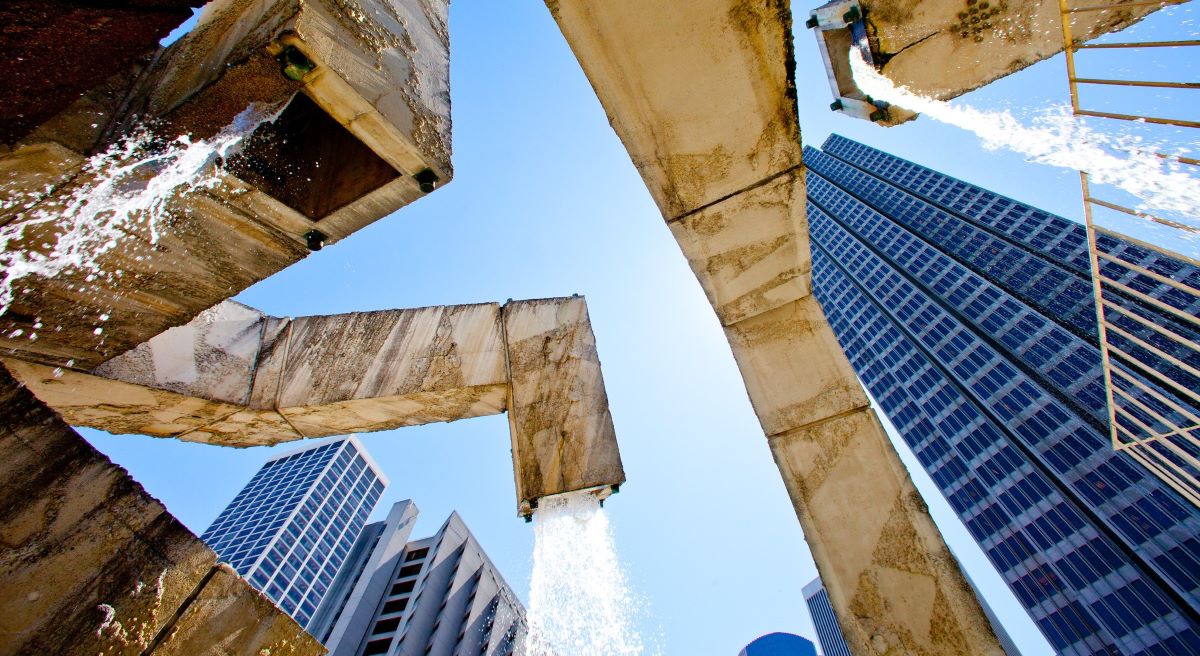 Climate change and drought are forcing California to reimagine its water supply future. One promising tool in the toolbox is water recycling, something California has been doing since the 1970s. Recycled water can be used for agricultural and landscape irrigation, industrial and commercial uses, seawater intrusion barriers, and groundwater recharge. More importantly, putting recycled water to use can free up potable water for other uses and provides a local source for water supplies.
Climate change and drought are forcing California to reimagine its water supply future. One promising tool in the toolbox is water recycling, something California has been doing since the 1970s. Recycled water can be used for agricultural and landscape irrigation, industrial and commercial uses, seawater intrusion barriers, and groundwater recharge. More importantly, putting recycled water to use can free up potable water for other uses and provides a local source for water supplies.
Governor Newsom’s water supply strategy calls for recycling and reusing at least 800,000 acre-feet of water per year by 2030 and 1.8 million acre-feet by 2040, with most of that additional recycling involving direct wastewater discharges that are now going to the ocean. The State Water Resources Control Board Board has invested a total of $1.8 billion in recycled water projects statewide over the last five years that are in various stages of development that when completed, will generate an additional 124,000 acre-feet of new water supply. There’s even more state and federal funding for water recycling projects on the horizon.
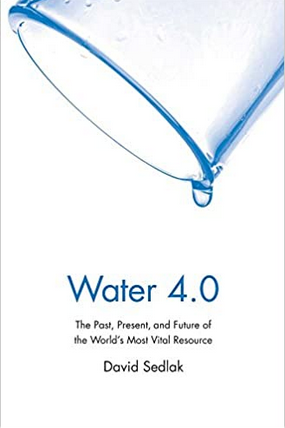 Most recycled water projects are what Dr. David Sedlak, a professor of civil and environmental engineering at UC Berkeley and the co-director of the Berkeley Water Center, describes as ‘water for wealthy people in cities.’ But the benefits of water recycling and desalination technologies can be expanded beyond just the large cities, he says. At the WateReuse conference held earlier this month in San Francisco, he issued five challenges to water professionals to find ways to expand the benefits of water recycling to smaller communities, the environment, and even agriculture.
Most recycled water projects are what Dr. David Sedlak, a professor of civil and environmental engineering at UC Berkeley and the co-director of the Berkeley Water Center, describes as ‘water for wealthy people in cities.’ But the benefits of water recycling and desalination technologies can be expanded beyond just the large cities, he says. At the WateReuse conference held earlier this month in San Francisco, he issued five challenges to water professionals to find ways to expand the benefits of water recycling to smaller communities, the environment, and even agriculture.
Dr. David Sedlak is a professor of civil and environmental engineering at UC Berkeley and the co-director of the Berkeley Water Center. He has been particularly interested in developing new approaches for managing the urban water cycle, and has authored the book, Water 4.0, which examines the ways in which we can gain insight into current water issues by understanding the history of urban water systems.
Here’s what Dr. Sedlak had to say, edited lightly only for clarity.
“I had a pandemic project that started during my sabbatical in 2019. In 2019, I went on a sabbatical, and I was thinking about what I wrote in the latter half of Water 4.0. In the part of that book that was at the end – not the old history, but the new history of what was happening in the future – I described how advanced technologies like reverse osmosis were making it possible for cities to break their historic reliance on imported water sources. I thought about this as being able to provide water for wealthy people living in cities.
“But I also had a sneaking suspicion that that was only part of a larger story that involved the global water crisis and that many other things were happening that went beyond the kinds of things that we do in the WateReuse Association and WateReuse Foundation. So I engaged in this project to write a book called “Water For All.” It will probably take another six or nine months before it comes out. But it will come out, I hope. And it describes six global water crises that the world is going to have to address in the coming one to two decades as we transition our legacy water systems to deal with the changes in the climate, the urbanization that’s happening around the world, and the continued global development that’s taking place.
“Now you might think, what do all these other crises have to do with WateReuse California? We’re really about water for wealthy people in cities. Well, I can tell you two important things about this more holistic view of water reuse: First, the things that happen in wealthy cities get repurposed and adapted by people living in low and middle-income countries as the technologies improve and become less expensive. So what you’re doing here in California will have impacts in Mexico and Sub-Saharan Africa and Southeast Asia, and South America in the future.
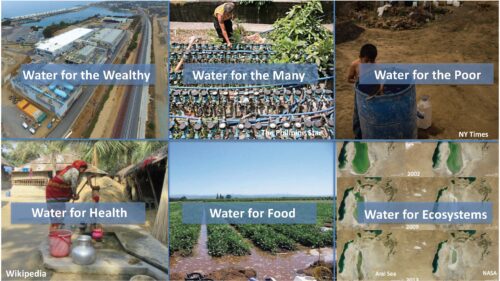 “But probably more relevant to people who are part of the WateReuse California community is the idea that California’s water crises are much deeper than providing water for wealthy people who live in cities. So I think the future of California water reuse is to start addressing some of these other crises after we solve this problem of water for wealthy people living in cities. So what I’d like to do today is give you some ideas about what those challenges are and how the technologies and experience of this community can be used to apply to them.
“But probably more relevant to people who are part of the WateReuse California community is the idea that California’s water crises are much deeper than providing water for wealthy people who live in cities. So I think the future of California water reuse is to start addressing some of these other crises after we solve this problem of water for wealthy people living in cities. So what I’d like to do today is give you some ideas about what those challenges are and how the technologies and experience of this community can be used to apply to them.
“But before I tell you about that future of California water reuse, I have to take you back to the past, to my first WateReuse conference. Now, it wasn’t 590 people, and we were in a lot more intimate setting in a slightly decrepit hotel in Seaside, California … At that conference, WateReuse California was toiling under the shadow of a National Academies report, which had called potable water reuse an option of last resort. Projects in California had been canceled due to the toilet-to-tap stigma. And the larger interest in water reuse didn’t extend much beyond California’s borders. We had a few kindred spirits in places like Scottsdale, El Paso, and Atlanta, but more or less, water reuse was a bit of a California thing.
“Well, what a difference a couple of decades can make. Looking at that program for this meeting, we can see that much of the vision of [early water reuse proponents] is really starting to come true. Southern California is on track to recycle all of its wastewater. The San Francisco Bay Area, which is a place where you didn’t really see a lot of major ambitious water reuse projects, has a number of them undergoing finance and design and will be built in the coming decades. And down on the Monterey Peninsula, the experiment that started with the irrigation of agricultural crops has continued to thrive.
“At a national level, the US EPA is now enthusiastic about water reuse through its water reuse action plan and is spending a lot of its time and effort translating the experiences of California to the rest of the nation. That’s a lot of progress.
 “Thinking about that progress, it would be easy for people in this room to become complacent. After all, the consulting engineers, utility representatives, and regulators here will have their hands full over the next three to five years, building all of this infrastructure that doesn’t yet exist.
“Thinking about that progress, it would be easy for people in this room to become complacent. After all, the consulting engineers, utility representatives, and regulators here will have their hands full over the next three to five years, building all of this infrastructure that doesn’t yet exist.
“As someone who’s been involved in research in support of the current transformation for a couple of decades can tell you, when you’ve finished building those projects, that won’t be the end of your mission. There’s a lot more to do and a lot that this community can do that it’s not yet doing.
“Today, I want to tell you about some of those things. I’ve identified five challenges that the water reuse community needs to take up after they complete their mission of providing a safe and affordable source of recycled water for rich people living in cities.
“These five challenges are really a question of anticipating the research needs and doing the development work before these things become an issue. Working together, I think we can create the know-how and the policy options to help the state transition its legacy water infrastructure into infrastructure ready for our new climate.
Challenge 1: Integrating build-scale water reuse
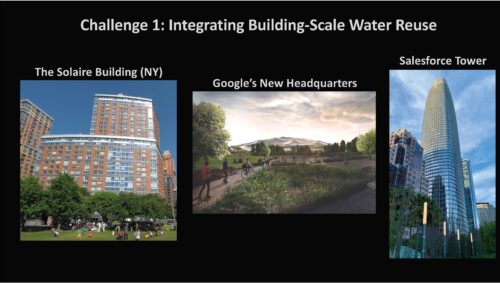 “The first challenge is integrating building-scale water reuse into a city’s existing infrastructure. So if you think about things like the Solaire building in New York City, Google’s new headquarters down on the peninsula, or the Salesforce tower just up the street from here, they’re examples of architects and developers engaged in a bold experiment to radically reduce the water footprint of buildings.
“The first challenge is integrating building-scale water reuse into a city’s existing infrastructure. So if you think about things like the Solaire building in New York City, Google’s new headquarters down on the peninsula, or the Salesforce tower just up the street from here, they’re examples of architects and developers engaged in a bold experiment to radically reduce the water footprint of buildings.
“And to be honest with you, members of the water reuse community have historically approached the question of building scale reuse with a little bit of skepticism. When your job is to come up with a stable water supply for an entire city, these projects don’t seem to add up too much. They tend to be expensive. They tend to be difficult to implement. And they tend to be hard to permit. And so historically, when people said, what about building scale reuse? The people in this community said, let’s stick with centralized reuse; we know we can create a lot of water quickly and efficiently. Well, all of that is starting to change. And I think those changes will be important for us in the future.
“Now I want to think about these changes that are happening here by thinking about the cost-effectiveness of them. When you look at these systems, they would appear at first not to have a positive return on investment. But when the government becomes the enthusiast who pushes you to build these kinds of projects, suddenly, things that seemed intractable become possible.
“For example, looking at the Solaire building in New York City, after the city realized the benefits of having that building’s ability to hold the water and prevent combined sewer overflows, the permitting got a lot easier, and subsidies came in. And it allowed the system to reach a point where it actually made financial sense to build.
“When you think about the way in which new technologies become less expensive as more of them are built around the place, we can imagine a point where it becomes attractive – not only in terms of regulations, not only in terms of establishing a green reputation – but it becomes attractive to a building developer to install an onsite reuse system because they’ll save money on their bills. In fact, we’re reaching a point where building buildings that are net zero water will become a reality in some parts of the world.
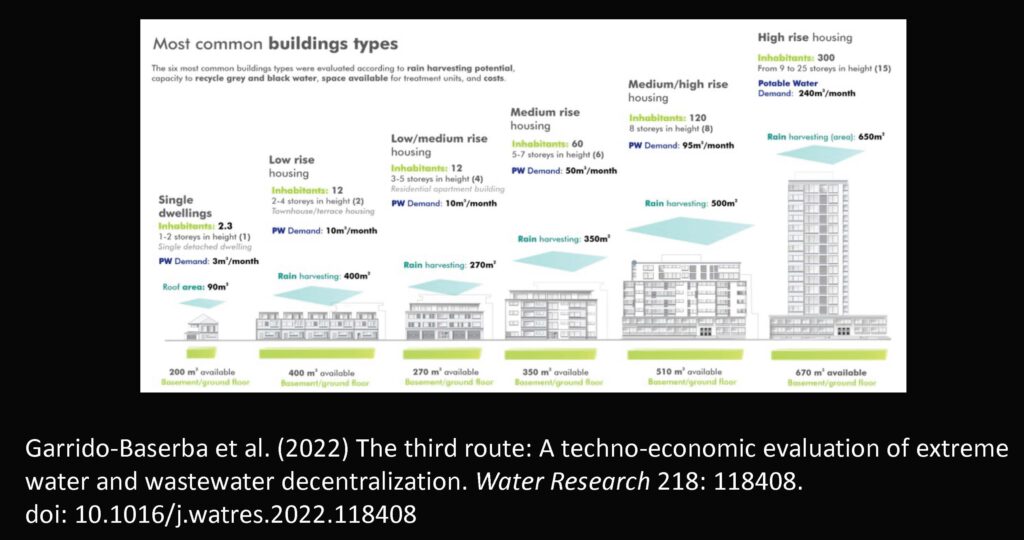 “I was recently part of a team of researchers that conducted a techno-economic analysis of net zero water buildings. We combined rainwater harvesting with building greywater recycling and looked at different building configurations in different parts of the world. And what we saw is that at current water tariff rates in many countries, it’s already cost-effective and attractive to build a building that doesn’t demand any water from the water infrastructure.
“I was recently part of a team of researchers that conducted a techno-economic analysis of net zero water buildings. We combined rainwater harvesting with building greywater recycling and looked at different building configurations in different parts of the world. And what we saw is that at current water tariff rates in many countries, it’s already cost-effective and attractive to build a building that doesn’t demand any water from the water infrastructure.
“Now, in California, we tend to have long, dry summers, and it’s probably going to be a long time before it’s economically attractive to have a net zero water building. But this illustrates the kind of attraction that we can see, not only from a regulatory push but a profitability factor, for the people who actually live and work in the buildings.
“I can imagine a future going forward when urban infill and the state’s plans to grow these systems mean that instead of happening slowly, like they’re happening now, we might see a great increase in onsite water reuse systems. They could become an important part of California’s effort to adapt its water to a new system.
Challenge 2: Water reuse and desalination for all Californians
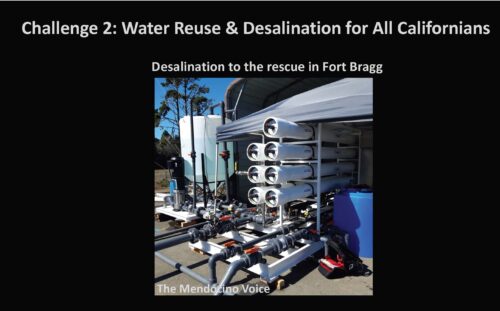 “The second challenge is bringing the benefits of water reuse and desalination to all Californians. If you think about the people who live in Orange County, Santa Barbara, and San Francisco, they’re among some of the wealthiest people not only in California but in the United States and the world. And even though those ratepayers complain to the utility managers when their water bills go up, it’s relatively easy to raise money to build water reuse and desalination systems in these places.
“The second challenge is bringing the benefits of water reuse and desalination to all Californians. If you think about the people who live in Orange County, Santa Barbara, and San Francisco, they’re among some of the wealthiest people not only in California but in the United States and the world. And even though those ratepayers complain to the utility managers when their water bills go up, it’s relatively easy to raise money to build water reuse and desalination systems in these places.
“Contrast that with our small cities and towns in California, where people aren’t as wealthy. The water system doesn’t have the same benefits of economies of scale. And the water supply is nowhere near as diverse. So you can see the challenges that California’s small communities have in providing water in a time of a changing climate. Places like Fort Bragg, Mendocino, and Cambria are really just the tip of the iceberg when we think about the challenges that are faced by California’s rural communities.
“In fact, it’s not those places we should be concerned about; it’s the many small communities and groups of people living in the Central Valley who lack access to water that we should be paying more attention to. Historically, the water reuse and desalination community hasn’t paid as much attention to these people because they don’t have the deep pockets to pay for projects.
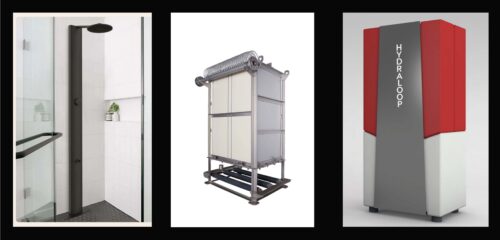 “In 2012, California passed a human right to water legislation. And in 2019, they followed up with $1.4 billion in funding to realize the human right to water. Many people have assumed that most of those funds would be going out to projects referred to as consolidation – the idea of extending pipes from existing water districts to people relying upon wells that are failing due to falling groundwater levels. But not every community that needs water will be close enough to this water source where consolidation is possible. And that’s where small-scale desalination and water reuse starts to become important.
“In 2012, California passed a human right to water legislation. And in 2019, they followed up with $1.4 billion in funding to realize the human right to water. Many people have assumed that most of those funds would be going out to projects referred to as consolidation – the idea of extending pipes from existing water districts to people relying upon wells that are failing due to falling groundwater levels. But not every community that needs water will be close enough to this water source where consolidation is possible. And that’s where small-scale desalination and water reuse starts to become important.
“Think about it. Small-scale water reuse systems have become modular, and their prices have dropped to the extent that they might be practical. Things like membrane bioreactors are now at a point where they’re reliable enough to start providing water for small communities without an operator present. But these are still expensive for these communities. So as we see the possibility of more funding coming into these projects and the great need that the state has, we should think about ways to take these modular technologies and pair them with other modular technologies like modular greywater recycling systems, ultra-low flow appliances, and even recirculating showers to drop the per capita water demand in a household and building and pair that with the modular recycling systems. I think there’s a lot of room for growth in the technologies and ideas this community can provide in this special need for the state of California.
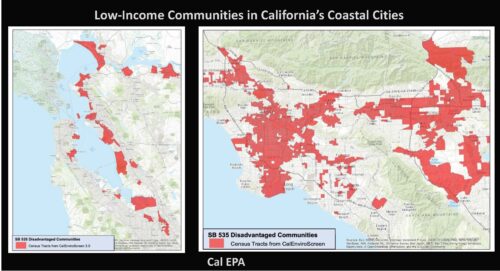 “The challenge of providing water for people who don’t have the means to pay for it goes beyond the rural parts of California. If you look at California’s coastal cities, not everyone is wealthy. In areas within the Bay Area and Southern California, people find their existing water and sewer bills unaffordable. Many of the policies that we’ve pursued in the past to enable water reuse have disproportionately benefited wealthy people. Cash for grass programs only benefit people who own homes and live in places where they have green lawns. Many of the projects that result in these green buildings that I showed you before only benefit people who are wealthy enough to live in green buildings.
“The challenge of providing water for people who don’t have the means to pay for it goes beyond the rural parts of California. If you look at California’s coastal cities, not everyone is wealthy. In areas within the Bay Area and Southern California, people find their existing water and sewer bills unaffordable. Many of the policies that we’ve pursued in the past to enable water reuse have disproportionately benefited wealthy people. Cash for grass programs only benefit people who own homes and live in places where they have green lawns. Many of the projects that result in these green buildings that I showed you before only benefit people who are wealthy enough to live in green buildings.
“If we want to extend the benefits of water reuse and desalination to the less affluent people who live in our cities, we have to start getting creative. There are many opportunities to do this, especially as funding comes from state and federal sources. For example, there are many communities where there’s not a lot of landscaping on the streets. And by using nonpotable water reuse, we can green the cities and not only make them more attractive places to live but make them better suited for dealing with the urban heat island effect, which is a real problem if you live in parts of our cities that all today consists mainly of concrete.
Challenge 3: Apply desalination to California agriculture
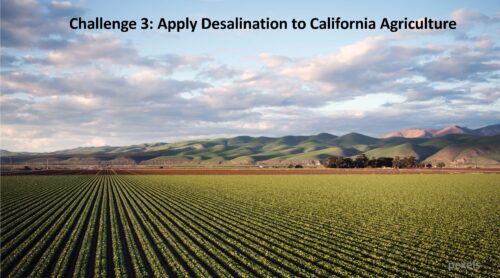 “The third challenge is applying water reuse and desalination to California agriculture. Now, for years members of this community had been very happy with the idea of wastewater recycling for agriculture, but the idea of using desalination for agriculture seemed far-fetched; it just seemed like it was too expensive to use seawater desalination to provide water for crops, especially because the water that was available for agriculture was so inexpensive.
“The third challenge is applying water reuse and desalination to California agriculture. Now, for years members of this community had been very happy with the idea of wastewater recycling for agriculture, but the idea of using desalination for agriculture seemed far-fetched; it just seemed like it was too expensive to use seawater desalination to provide water for crops, especially because the water that was available for agriculture was so inexpensive.
“Advances in seawater desalination are reaching a point where the prices are dropping. And there may be some parts of the world where seawater desalination is appropriate for high-intensity greenhouse operations, growing things like cut flowers and specialized horticultural products.
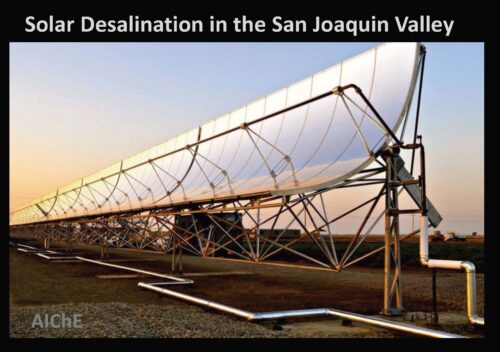 “But the real opportunity for desalination in California can be found in our Central Valley. In these places, we have sources of brackish groundwater located at depths that make them feasible for exploitation. And that brackish groundwater is much less expensive to desalinate than seawater because the salt levels are so much lower.
“But the real opportunity for desalination in California can be found in our Central Valley. In these places, we have sources of brackish groundwater located at depths that make them feasible for exploitation. And that brackish groundwater is much less expensive to desalinate than seawater because the salt levels are so much lower.
“So by taking advantage of sunlight or renewable energy that becomes very cheap during certain parts of the day when there’s excess generating capacity, entrepreneurs have shown us that they’re already reaching a point where they can produce desalinated water for agriculture at costs that are competitive to what farmers are paying on the open market. The challenge here has been getting this water from the places that it’s desalinated to the places that need it. I think if we can address that challenge in the future, we may be able to make a contribution to agriculture.
 “There’s a second issue where desalination could be very important to California agriculture. And that’s the challenge of salinization of soils. Many of our groundwater basins, especially in the southern San Joaquin Valley, are so-called closed basins where we’ve made our irrigation technologies much more efficient over time, but we haven’t managed to send the salts out of the area, and they’re accumulating in the soil.
“There’s a second issue where desalination could be very important to California agriculture. And that’s the challenge of salinization of soils. Many of our groundwater basins, especially in the southern San Joaquin Valley, are so-called closed basins where we’ve made our irrigation technologies much more efficient over time, but we haven’t managed to send the salts out of the area, and they’re accumulating in the soil.
“So, concerned about the effects of soil salinization and water logging that occur when salts aren’t flushed out of the soil, a group of farmers and the regulatory authorities in the Central Valley recently proposed the construction of a 280-mile pipeline that would be paired with a series of small scale desalination plants; the desal plants would take the agricultural runoff from irrigated farm fields, desalinate it, use the freshwater for agricultural purposes, and send the salinated water to San Francisco Bay for disposal.
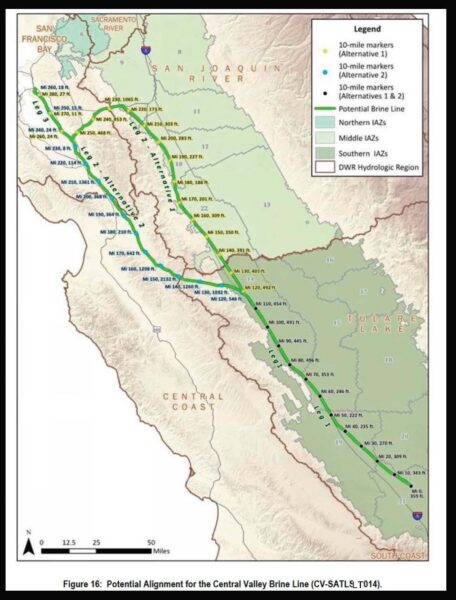 “Now, the CV-SALTS project may seem like a far-fetched moonshot to some of you when you think about the price tag of over $3 billion a year to build and operate it. But we should remember that the brine line that serves the Santa Ana River Basin has made a huge difference in the ability to use water reuse and desalination in the Inland Empire. So having a brine line can be really important.
“Now, the CV-SALTS project may seem like a far-fetched moonshot to some of you when you think about the price tag of over $3 billion a year to build and operate it. But we should remember that the brine line that serves the Santa Ana River Basin has made a huge difference in the ability to use water reuse and desalination in the Inland Empire. So having a brine line can be really important.
“If you think about it, California is in the process of ending its historic reliance on fossil fuels. And we have pipelines running all over the state, bringing gasoline up and down places like the Central Valley. What if we were to take one of those pipelines, which will go out of business in the next couple of decades, and repurpose it for brine disposal? Just a thought.
Challenge 4: Remove contaminants from concentrate
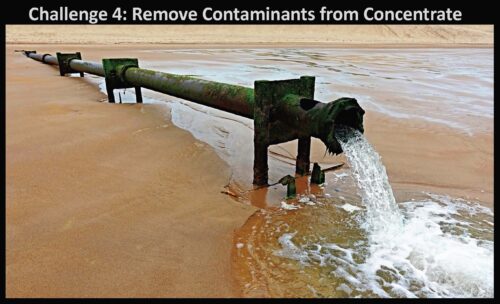 “The fourth challenge is removing contaminants from the concentrate. Historically, water reuse projects had a free ride when it came time to get rid of the reverse osmosis concentrate; you simply took it and put it in the pipeline that was discharging to the ocean. Well, that dilution is the solution to pollution fix is going to go away in the future for a variety of reasons.
“The fourth challenge is removing contaminants from the concentrate. Historically, water reuse projects had a free ride when it came time to get rid of the reverse osmosis concentrate; you simply took it and put it in the pipeline that was discharging to the ocean. Well, that dilution is the solution to pollution fix is going to go away in the future for a variety of reasons.
“The state of California has become particularly interested in ocean acidification. And one of the main causes of ocean acidification has been identified as the discharges of organic matter and nutrients from wastewater treatment plants. Simply removing the water and recovering it in water reuse projects and not treating the nutrients and the organic matter doesn’t do anything to solve that problem. So in the future, we’re going to be under more pressure to treat that reverse osmosis concentrate.
“In addition, when we rely upon reverse osmosis for our projects, we have to dispose of it. And projects like the ones proposed in the San Francisco Bay, where there’s insufficient mixing and dilution of the RO concentrate at the outfalls of discharge projects, are raising concerns among regulators that we might be creating zones in the San Francisco Bay with elevated levels of things like copper, nitrate, and organic chemicals like PFAS. So that’s starting to be one of the impediments to projects being built.
“When you think about it, taking the contaminants in wastewater and concentrating them in a much smaller volume should make them easier to treat. But the reality is that many of our existing engineering technologies struggle with the complex matrix of reverse osmosis concentrate.
“My research group has been interested in this challenge for about seven or eight years now. And we’ve been working with Valley Water to try to support their efforts to safely manage the concentrate that they would produce from their project in the South Bay. We started by looking at a surface flow wetland that would use sunlight and microbes to remove the nitrate and organic chemicals but found that it wasn’t able to treat the concentrate sufficiently.
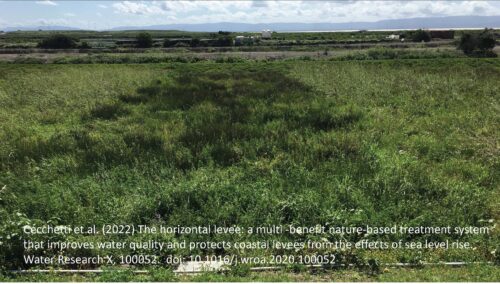 “So we turned our attention to something that we refer to as a horizontal levee. This is a picture of the pilot scale horizontal levee system we’ve been studying in San Leandro. What this system is, is a subsurface wetland where we take the RO concentrate; we put it in a layer of sand and gravel mixed with woodchips below the surface, and the microbes living in that subsurface layer remove the nutrients and the trace organic contaminants while creating a habitat on the surface. This habitat on the surface goes between the coastal levee and the Bay to protect the coastal levees from the effects of sea level rise.
“So we turned our attention to something that we refer to as a horizontal levee. This is a picture of the pilot scale horizontal levee system we’ve been studying in San Leandro. What this system is, is a subsurface wetland where we take the RO concentrate; we put it in a layer of sand and gravel mixed with woodchips below the surface, and the microbes living in that subsurface layer remove the nutrients and the trace organic contaminants while creating a habitat on the surface. This habitat on the surface goes between the coastal levee and the Bay to protect the coastal levees from the effects of sea level rise.
“This project may not be particularly cost-effective relative to some of the engineering treatment processes that we might use. But it has the added benefits of solving multiple problems simultaneously. It has the benefit of not only improving the water quality of the concentrate but also providing protection to coastal infrastructure and creating native habitats. And as a result, it’s particularly popular among members of the public and the regulatory authorities. And so it’s been moving ahead with our projects.
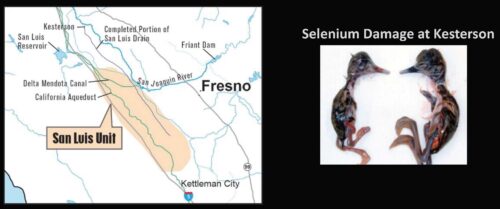 “The issue of reverse osmosis concentrate and the need to treat it is not just limited to San Francisco Bay. The reverse osmosis concentrate produced by desalination projects causes its own set of problems. Those of you who’ve been in the industry for a number of years might remember the ecological catastrophe at the Kesterson reservoir when agricultural drainage water contaminated with selenium was allowed to accumulate in a pond where a lot of wildlife nested. The problem of finding a way to deal with the selenium-contaminated reverse osmosis concentrate or drainage water produced by farms has been studied by the Bureau of Reclamation for about 20 years in their project in the San Luis unit of the San Joaquin Valley. They’ve been trying to use reverse osmosis coupled with biological treatment to remove selenium to make it safe to discharge that water.
“The issue of reverse osmosis concentrate and the need to treat it is not just limited to San Francisco Bay. The reverse osmosis concentrate produced by desalination projects causes its own set of problems. Those of you who’ve been in the industry for a number of years might remember the ecological catastrophe at the Kesterson reservoir when agricultural drainage water contaminated with selenium was allowed to accumulate in a pond where a lot of wildlife nested. The problem of finding a way to deal with the selenium-contaminated reverse osmosis concentrate or drainage water produced by farms has been studied by the Bureau of Reclamation for about 20 years in their project in the San Luis unit of the San Joaquin Valley. They’ve been trying to use reverse osmosis coupled with biological treatment to remove selenium to make it safe to discharge that water.
“One of the things that happened to me at that early WateReuse California meeting was driving home from that meeting; I had a moment where I felt very strange because I had the sense that by participating in WateReuse in California, I was indirectly doing the bidding of real estate developers who were going to continue the suburban sprawl that was destroying the California that I’d come to know and love. And I had been concerned about the way in which water reuse has enabled the development of water-stressed parts of California.
“But in the intervening 20 years or so, I’ve also recognized that development is going to happen in California, there’s going to be people who want to live here, and they’re going to be developers who figure out how to get water rights. So I think it’s up to us to figure out ways to make water reuse work with the environment.
Challenge 5: Water reuse and desalination for the environment
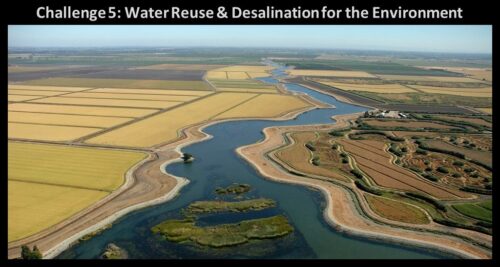 “The fifth challenge is employing water reuse and desalination to protect and improve the environment. Over the past few years, I’ve been particularly struck by something that’s gone on in the discussions about greenhouse gas emissions. We’ve gone from talking about reducing our greenhouse gas emissions to the idea of creating net negative greenhouse gas emission projects. That is, we’ve come to recognize that it’s not going to be enough to simply cut our greenhouse gas emissions; we’re going to have to remove CO2 from the atmosphere if we want to leave the next generations with the kind of world that we hope that they’ll have.
“The fifth challenge is employing water reuse and desalination to protect and improve the environment. Over the past few years, I’ve been particularly struck by something that’s gone on in the discussions about greenhouse gas emissions. We’ve gone from talking about reducing our greenhouse gas emissions to the idea of creating net negative greenhouse gas emission projects. That is, we’ve come to recognize that it’s not going to be enough to simply cut our greenhouse gas emissions; we’re going to have to remove CO2 from the atmosphere if we want to leave the next generations with the kind of world that we hope that they’ll have.
“I think the same kind of thinking applies to water in California. We have an obligation not only to build water reuse projects that replace water that’s lost to climate change and aridification or to make up water to support cities that want to continue to grow; we also have an obligation to use water reuse to return water to the environment to try to help the natives of the ecological systems in California make it through this period of extreme stress due to climate change and to compensate them for the damage that we’ve done to them during this 100 years of water infrastructure development.
“So my fifth challenge in bringing water reuse and desalination to the environment means that when we build water reuse projects, we should start thinking about ways in which they can be used to allow more of the water that we’re storing in our reservoirs to flow into the environment. So, imagine building a reuse project where some of the water savings goes to the city, and some of the water savings goes to reduce that city’s need for imported water and allow the increase in environmental flows.
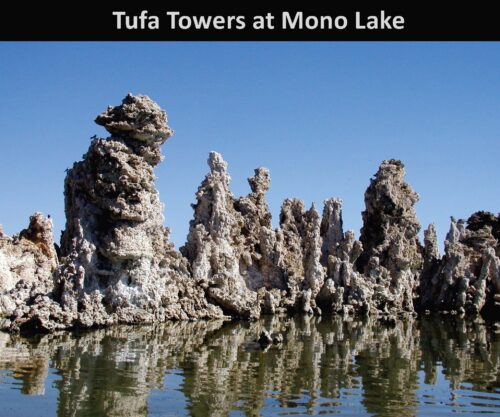 “Think about it. More water flows through the Sacramento San Joaquin Delta because water reuse projects reduce a city’s demand for imported water. Water flows into the Salton Sea because we use the Colorado River more wisely through water reuse and desalination.
“Think about it. More water flows through the Sacramento San Joaquin Delta because water reuse projects reduce a city’s demand for imported water. Water flows into the Salton Sea because we use the Colorado River more wisely through water reuse and desalination.
“Now, if this sounds far-fetched to you, it’s not. It’s essentially the same approach that the city of Los Angeles did when they were forced to reduce the amount of water they were taking from the tributaries to Mono Lake. So after the Mono Lake decision, Los Angeles became much more serious about water reuse and reducing its demand for water from imported locations. That was brought upon them by a legal decision, but this is something that we can do ourselves.
In conclusion …
“So, in summary, since its humble beginnings, California WateReuse has come a long way. We’ve made great progress. But there’s still a lot more we can do. I hope I’ve shown you today that it’s more than just building water for wealthy people living in cities.
“Our efforts to build water for wealthy people in cities are going to help people in low and middle-income countries, but I think the California water reuse has the potential to make major contributions throughout the state of California, not just in our wealthy cities.
“I think the things we do are really important for the rest of the world, and they will continue to watch us and learn from us.”
- More information on recycled water, from the Water Management Toolbox at Maven’s Notebook
- Coverage of recycled water on Maven’s Notebook
- Water Boards Recycled Water Policy and Regulations, webpage at the State Water Board
- Division of Drinking Water’s Recycled Water Information, webpage at the State Water Board
- WateReuse Association website


